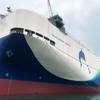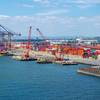Kirby Corp, the largest U.S. tank barge operator, has agreed to buy Hollywood Marine Inc., an inland tank barge company based in Houston, for approximately $325 million. Kirby, also based in Houston, said the purchase price consists of $90 million in stock, $135 million in cash and the assumption or refinancing of about $100 million of Hollywood debt.
"Hollywood's operations are complementary to our core inland tank barge operation and are an excellent fit within Kirby's strategy of growing our core businesses through synergistic acquisitions," Kirby CEO and President J.H. Pyne said. "The potential for cost savings and improved efficiency through the merger of the two companies is substantial."
As part of the deal, Kirby said it would name C. Berdon Lawrence, Hollywood Marine's president and principle shareholder, as chairman of Kirby and make Kirby's current chairman, George Peterkin, chairman emeritus.
Kirby said it plans to merge the privately-held company into one of its subsidiaries and that the acquisition would boost its profits in the year 2000 and add to cash flow. The acquisition is scheduled to close in October.
Financial Implications
Standard & Poor's placed its triple-'B' corporate credit and senior unsecured debt ratings for Kirby Corp. on CreditWatch with negative implications. The CreditWatch listing reflects an increased debt burden Kirby will incur as a result of its acquisition.
Financing for the cash portion of the transaction will be through Kirby's existing bank credit agreement and medium term note program. Pro forma for the transaction, Standard & Poor's estimates Kirby's debt leverage will rise significantly, with debt to total capital rising to about 62 percent from 47 percent.
However, the merger with Hollywood should present significant cost reduction opportunities, as the inland tank barge operations of Kirby and Hollywood are highly complementary. Substantial savings are expected from better fleet management and asset utilization, procurement, and unit overhead reductions.
The merger also will strengthen Kirby's already leading market position in inland tank barge transportation of chemicals and petrochemicals, refined petroleum products, black oil and pressurized products along the Gulf Intracoastal Waterway, the Houston Ship Channel and the lower Mississippi River.
Duff & Phelps Credit Rating Co. (DCR) is also reviewing the acquisition.
The combined entity would have sales in excess of $450 million and should benefit from clearly identifiable cost savings due to greater efficiencies in purchasing and logistics. DCR views the proposed merger positively from an operational viewpoint as the respective businesses appear to be complementary.
Company Origins
Hollywood Marine launched its first barge in 1970, operating from the small town of Hollywood, just outside Lake Charles, La. Within a few years, the growing company moved its corporate headquarters to Houston, and built operations facilities in Houston, Corpus Christi, Texas, and New Orleans.
At the time of its acquisition, Hollywood was one of the largest tank barge companies on the Gulf Coast. Its distinctive red and white vessels move and handle a broad range of petroleum products. The company transports petrochemicals, pressurized gases and black oils; provides ship bunkering at major ports; and stores petroleum products at its terminal facilities.
Hollywood Marine's fleet consists of 256 barges (190 double-skinned, 23 single-skinned and 43 pressurized) and 104 inland towboats operating along the Gulf Intracoastal Waterway, the Houston Ship Channel and the lower Mississippi River. The company earned revenues of $168 million in 1998.
The history of Kirby can be traced back to 1921, when John Henry Kirby, a pioneer in the development of the Houston business community, formed Kirby Petroleum Company, an oil and gas exploration and development company. Today, the name Kirby is a well recognized name in Houston, with the Kirby Building and the Kirby Mansio" in downtown Houston and a major Houston street, Kirby Drive, all named in John Henry Kirby's honor.
Kirby Petroleum Company operated as a Houston based independent oil and gas exploration and development company until 1956 when, after the sale of its producing properties, the remaining non-producing acreage was merged with three other independent oil and gas companies to form Kirby VenSyn Petroleum Company. As a result of the mergers, the Murchison family of Dallas, noted for its prior ownership of the Dallas Cowboys, owned approximately 35 percent of Kirby. The Murchison family remains shareholders of Kirby today.
Kirby VenSyn Petroleum Company changed its name to Kirby Petroleum Co. in 1957 and adopted the name Kirby Industries, Inc. in 1967. As was quite common for the time, Kirby Industries operated as a conglomerate with many different operations: oil and gas exploration and development through Kirby Petroleum Co.; the manufacture of steel buildings through Kirby Building Systems, Inc.; and marine transportation through Dixie Carriers, Inc., which was acquired in 1969. Even though Kirby Industries had many different operations, the primary emphasis was on oil and gas exploration and development.
Complete Liquidation
In 1974, with the underlying value of Kirby Industries assets substantially higher than the stock price, the board of directors adopted a plan of complete liquidation, destined to distribute to the stockholders of Kirby Industries cash and the stocks of certain companies. The oil and gas producing assets of Kirby Petroleum and the assets of Kirby Building Systems were sold, with the cash proceeds distributed to Kirby Industries stockholders. The liquidation also resulted in the stocks of Dixie Carriers and Universal Insurance and the nonproducing oil and gas acreage, royalty interests and interests in oil and gas limited partnerships being transferred to a new corporation named Kirby Exploration Company. Kirby Exploration Company became publicly owned on September 30, 1976, when its common stock was distributed pro rata to the former Kirby Industries stockholders.
From 1976 through 1988, Kirby Exploration Company was engaged in oil and gas exploration and development, marine transportation through Dixie Carriers, and property and casualty insurance through Universal Insurance. During that period, as in the past, Kirby's primary emphasis remained on oil and gas exploration and development. The oil and gas boom of the early 1980's was a very active period for the oil and gas operation, with extensive exploratory drilling in the Fletcher Field of Oklahoma. The field was not as productive as anticipated, with Kirby relying on the cash flow of Dixie Carriers and the stock value of Universal Insurance to financially support the oil and gas operation.
Solely Marine Transportation
During 1987, after an extensive study and much consideration, the board of directors determined the future of Kirby should be concentrated on marine transportation and related activities. In April 1988, the oil and gas assets were sold and Kirby embarked on its marine transportation strategy. Following that strategy, in 1990 the name of the company was changed to Kirby Corporation, retaining the Kirby identity as a publicly traded company.
Since 1989, Kirby has continued its emphasis in the marine transportation industry through acquisitions of marine companies, acquiring Alamo Inland Marine Co., Brent Towing Company, Inc., Sabine Towing & Transportation Company, Ole Man River Towing Company, Scott Chotin, Inc. and the transportation assets of Dow Chemical Company, as well as numerous other smaller acquisitions.
The history of Dixie Carriers, Kirby's principal marine operating company, can be traced to 1948, when a group of Houston investors, including George Peterkin, Sr., father of Kirby's chairman of the Board, George Peterkin, Jr., purchased River Terminals Corporation, a transporter of petroleum between Houston and New Orleans and cotton down the Mississippi River to New Orleans. Sabine Towing, acquired in 1992, has a history dating back to 1909. Dixie Carriers and Sabine Towing, as well as numerous of the other marine companies acquired by Kirby, were very instrumental in the development of the U.S. inland waterway system, which is composed of thousands of miles of navigable rivers, canals and coastal waterways. The nation's waterway serves as the backbone of the U.S. distribution system with over 1.1 billion short tons of cargo moved annually by domestic shipping. The majority of U.S. refineries and major chemical manufacturing plants are built near the water's edge to take advantage of this efficient transportation resource.
Single Identity
As of January 1, 1998, Kirby's inland tank barge companies began operating under a single name: Kirby Inland Marine. This final step completed the consolidation of Kirby's canal, linehaul, and river fleets into a closely integrated, highly efficient entity. The Kirby Inland fleet of 500+ tank barges and 125+ towboats has a total liquid cargo capacity of 9.7 million barrels and represents about 19 percent of the total U.S. tank barge capacity. The primary cargoes transported by this fleet are chemicals, petrochemical feedstocks, gasoline additives, refined petroleum products, and liquid fertilizer. Kirby Inland's service area spans America's inland waterway network: The Gulf Intracoastal Waterway, the Mississippi River System, the Illinois River, the Ohio River and numerous other waterways.
Kirby's Offshore segment operates one dry-bulk barge/tug unit and, through two partnerships, manages five additional dry-bulk barge/tug units in coastwise trade. Kirby's Diesel Engine Services segment is engaged in the overhaul and servicing of large, medium-speed diesel engines employed in marine, power generation and rail applications.
Kirby Fleet Analysis
Kirby Inland Marine's Canal operation encompasses the transportation of petrochemical feedstocks, processed chemicals and refined products along the Gulf Intracoastal Waterway, the Mississippi River below Baton Rouge, and in the Houston Ship Channel. Typical service includes the movement of petrochemical feedstocks between refineries and the delivery of processed chemicals and feedstocks to chemical plants and waterfront terminals. A canal tow consists of one to five barges, pushed by an 800 to 1,900 hp towboat.
Kirby Inland Marine's River operation transports petrochemical feedstocks, processed chemicals, refined petroleum products and agricultural chemicals along the Mississippi, Illinois, Ohio and Arkansas rivers. A river unit tow typically includes four to eight barges, pushed by a 2,000 to 5,600 hp towboat. River unit tows are generally considered "dedicated", with the same barges and towboat used for each trip.
Kirby Inland Marine's Linehaul operation transports petrochemical feedstocks, processed chemicals, agricultural chemicals and lube oils along the Mississippi, Illinois and Ohio rivers as well as the Gulf Intracoastal Waterway. A linehaul canal tow usually comprises three to five barges with a 1,400 to 1,900 hp towboat.
A linehaul river tow is much longer, consisting of 10 to 25 barges and using a 3,000 to 5,600 hp towboat. The linehaul river tow functions similarly to a freight train, dropping off and picking up barges as it moves up and down the river.
Hollywood Fleet Analysis
On a barrels-moved basis, Hollywood is one of the largest barge transporters of petrochemical and refined products in the U.S. All barges in the petrochemical fleet are equipped with vapor emission control piping and are capable of closed loading and discharging operations.
Hollywood operates the largest pressurized barge fleet in the U.S. These pressurized barges can handle products requiring pressures up to 265 psi. Hollywood tankermen and shore personnel are specially trained in pressurized transportation technology and have a safety record unmatched in the industry.
The Hollywood fleet of black oil barges is equipped to handle the requirements of a wide range of product characteristics. Many of these barges feature high-capacity pumps and onboard heating systems for viscous oils including asphalt. Such flexibility contributes to Hollywood's ability to satisfy customer needs for transporting a wide range of cargo viscosities.
Ship owners and bunker suppliers rely on Hollywood's fleet of bunkering barges, one of the largest along the Gulf Coast. These barges feature flow-through booms and are dispatched and deployed using a satellite communications system. This system also provides customers with up-to-the-minute position and scheduling information.-Chris Palermo
Sponsored Content
Lower carbon intensity fuels to support your operations

Subscribe for
Maritime Reporter E-News
Maritime Reporter E-News is the maritime industry's largest circulation and most authoritative ENews Service, delivered to your Email five times per week










